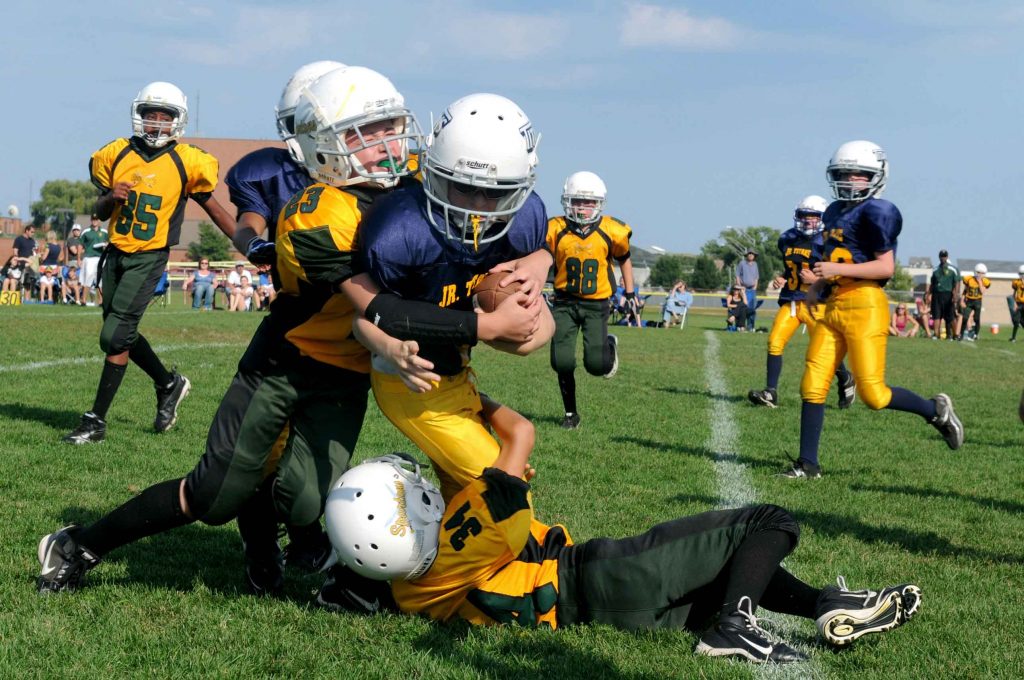Nothing is more fun than getting together with loved ones on a Friday night and going out to a local football or baseball game. Not only are sports fun to watch, they’re also incredibly healthy for the bodies and minds of athletes. Unfortunately, they can also cause injuries. It’s important to recognize common issues and take steps to prevent them. With a little preparation, we can keep our favorite sports safe and our athletes healthy. Let’s explore the most common types of sports injuries.
The Most Common Causes of Sports Injuries
Most sports injuries are caused by one of these three things:
- Repeating a body motion too often. This can happen when players are in training and trying to master a specific move. This might happen to a starting pitcher who plays a little too often and practices a lot in his off time.
- An athlete moving their body or landing unnaturally. This is common in sports which involve starting and stopping quickly, twisting suddenly, and jumping long distances. A quarterback tearing his ACL is a common example.
- Being hit by an object or another player, like getting kicked or punched by accident, hit by a ball, or tripping over an obstacle. These aren’t as common, but they can sometimes be the most painful and damaging. Think of a basketball player whose legs get caught up in another’s and falls.
What sport has the most injuries?
The sports with the most injuries are usually the ones in which athletes are in direct contact with one another. Unfortunately, you may not like the top answer.
For Men:
- Tackle football – more injures during competition
- Wrestling – more injuries during practice
For Women:
- Gymnastics – more dangerous overall
- Soccer – more dangerous during competitions
Strains and sprains
Because of their similar names and symptoms, strains and sprains often get confused. Both involve tearing and overstretching soft tissues around your joints, and their symptoms include swelling, joint pain, and a lack of flexibility. However, they have some key differences.
- Sprains – Sprains are damaged ligaments, which are the tissues that connect your bones to other bones. Bruising is common in sprains but not strains.
- Strains – Strains are damaged muscles or tendons, which connect muscles to bones. Muscle spasms are common in strains but not sprains.
Sprains and strains often occur in ankles, knees, and wrists, though they can happen anywhere where you have joints. Sprains more often occur from falls and collisions that knock joints out of their proper positions. For instance, if a football player gets tackled and lands on his elbow or a softball outfielder trips in a hole and falls while running toward a fly ball, it might result in an elbow sprain.
Strains are more common from repetitive actions that wear down a joint. If a baseball player spends a little too much time practicing in the batting cages, he might get a strain. Both injuries vary in severity, from minor stretches to complete tissue tears.
You can help prevent sprains and strains by warming up and stretching before you play. A healthy diet will also help keep muscles strong. If you find yourself particularly susceptible to strains and sprains, protective equipment like braces can help.
Concussions
Nothing gets more gasps from a crowded football stadium than a painful looking tackle, and for good reason. A bad tackle can lead to one of the most severe sports injuries: a concussion.
A concussion is a traumatic brain injury usually caused by a blow to the head. Concussions are very serious and require immediate medical attention. They occur in men most often during football and in women during soccer, with football players being the most at risk overall. They are a common reason why football is often considered to be one of the sports with the worst injuries.
Thankfully, concussions symptoms are easy to recognize. They include:
- Headaches – Occurs in 95% of cases
- Dizziness – most cases
- Trouble concentrating – most cases
- Confusion – some cases
- Light sensitivity – some cases
In the past, symptoms that went away in less than fifteen minutes were seen as mild enough to let someone keep playing. These days, it’s known that athletes should not return to play until a medical professional says it’s okay. Even if it’s in the middle of a big game, don’t push it!
Untreated concussions can result in serious injury or death. You can help prevent them by always wearing a helmet when playing high-risk sports and training yourself to avoid head collisions with other players.
Patellofemoral Syndrome (Knee Pain)
Patellofemoral Syndrome (PFM) is a fancy way of saying pain around your kneecap, which is also known as your patella. It’s extremely common in athletes who play sports that involve jumping and running, especially long distances, so you’ve likely seen athletes suffer from it at track and field events. Many people call it “runner’s knee,” and it’s reported to make up 25-30% of injuries treated at sports medicine clinics.
Preventing PFM is hard, but you can reduce your risk while still enjoying your favorite sports. Stretching and warming up will help your flexibility, and weight training can strengthen muscles like quadriceps and hip abductors that will help keep your legs balanced overall. It’s also important to wear shoes with good shock absorption and pay attention to good form while training and competing. It also helps to increase intensity little by little.
Fractures
Fractures are another term for broken bones, but most people call complete breaks “broken”. A fracture is any break in the continuity of a bone, including small partial cracks. They can occur in athletes because of repetitive stress or acute trauma. This is a fancy way of saying getting hit hard, landing unnaturally, or overusing a body part. Stress fractures from repetition are the most frequent type in sports. Fractures usually occur in the hands, collarbone, ankle, wrist, and feet, and they can happen during any sport.
Big increases in intensity or length of training raise your risk of stress fractures, so if you want to train harder, it’s important to make changes little by little over weeks or months. It’s also important to wear proper equipment and use good form. Calcium and vitamin D will improve bone strength, so don’t forget to get plenty of sunshine and eat healthy meals.
Weight training also strengthens bones, helping prevent all types of fractures. Even if your sport doesn’t require a lot of strength, cross-training with weights has many benefits.
Shoulder injuries
If you’re a baseball fan, you might have seen a pitcher icing their shoulder after a long game. Shoulder injuries are one of the most common sports injuries because of how often shoulders are used. Other sports like football and gymnastics, which involve using the shoulder to either support your body weight or absorb impact, can also put athletes at risk. There are a few common types of shoulder injuries.
- Shoulder dislocations – These happen when two bones are separated at the shoulder joint. Usually, these bones are the humerus and scapula. Dislocations can also occur at the ACJ joint when the clavicle and scapula are separated. If this happens to you, you’ll likely hear a popping sound. Bones can be popped back into their normal joints, but you should always let a healthcare professional do this.
- Torn rotator cuff – the rotator cuff is a group of tendons that let your shoulder move freely, so these injuries can result in pain, weakness, and a worse range of motion. These are common in swimmers, tennis players, and baseball players.
- Slap Tears – Superior Labral Antero-Posterior (SLAP) tears are injuries that can occur in a connective tissue called cartilage that surrounds your shoulder. They also most commonly happen in sports with overhead throwing motions. However, they can also result from falling or being tackled. They are characterized by a looseness and loss of power in the shoulder muscle. They’re often accompanied by a popping or clicking sound.
As with many of these other injuries, you can help prevent shoulder injury through cross-training with weights, stretching, and warming up properly. Maintaining good posture can also help strengthen the shoulder.
If you receive a sports injury, Xpress Wellness Urgent Care is here to help
While we wish you nothing but health and success while playing your favorite sports, accidents happen. When they do, you need a clinic that treats sports injuries. As long as your injury is non-life threatening, Xpress Wellness will help restore you to peak performance. Find an Xpress Wellness clinic near you to get patched up and back on the field, court, gym or wherever your sport takes you in no time.



